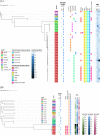Disinfectant Susceptibility of Third-Generation-Cephalosporin/Carbapenem-Resistant Gram-Negative Bacteria Isolated from the Oral Cavity of Residents of Long-Term-Care Facilities
- PMID: 36515531
- PMCID: PMC9888285
- DOI: 10.1128/aem.01712-22
Disinfectant Susceptibility of Third-Generation-Cephalosporin/Carbapenem-Resistant Gram-Negative Bacteria Isolated from the Oral Cavity of Residents of Long-Term-Care Facilities
Abstract
We have recently reported the isolation of third-generation-cephalosporin-resistant Gram-negative bacteria from the oral cavity of residents of a long-term-care facility (LTCF). Since disinfectants are often used in the oral cavity, it is important to investigate the disinfectant susceptibility of oral bacteria. Here, we evaluated the susceptibilities of Gram-negative antimicrobial-resistant bacteria (GN-ARB), including Pseudomonas, Acinetobacter, and Enterobacteriaceae, obtained from the oral cavity of residents of LTCFs to povidone-iodine (PVPI), cetylpyridinium chloride (CPC), benzalkonium chloride (BZK), and chlorhexidine chloride (CHX). We also evaluated the susceptibilities of isolates from the rectum to the same agents to compare the susceptibility profiles of oral and rectal isolates. Next, we investigated the relationship between their susceptibility and disinfectant resistance genes delineated by whole-genome sequencing of the isolates. Additionally, we evaluated the correlation between disinfectant-resistant GN-ARB and clinical information. In oral GN-ARB, the MIC of PVPI showed almost identical values across isolates, while the MICs of CPC, BZK, and CHX showed a wide range of variation among species/strains. In particular, Pseudomonas aeruginosa exhibited high-level resistance to CPC and BZK. The disinfectant susceptibility of rectal GN-ARB showed a tendency similar to that of oral GN-ARB. The presence of qacEΔ1 was correlated with CPC/BZK resistance in P. aeruginosa, while other species exhibited no correlation between qacEΔ1 and resistance. Multiple analyses showed the correlation between the presence of CPC-resistant bacteria in the oral cavity and tube feeding. In conclusion, we found that some oral GN-ARB isolates showed resistance to not only antibiotics but also disinfectants. IMPORTANCE Antibiotic-resistant bacteria (ARB) are becoming a serious concern worldwide. We previously reported the isolation of third-generation-cephalosporin-resistant Gram-negative bacteria from the oral cavity of residents of a long-term-care facility (LTCF). To prevent infection with ARB in hospitals and eldercare facilities, we must pay more attention to the use of not only antibiotics but also disinfectants. However, the effect of disinfectants on ARB is unclear. In this study, we evaluated the susceptibility of Gram-negative ARB (GN-ARB) from the oral cavity of residents of LTCFs to some disinfectants that are often used for the oral cavity; we found that some isolates showed resistance to several disinfectants. This is the first comprehensive analysis of the disinfectant susceptibility of oral GN-ARB. These results provide some important information for infection control and suggest that disinfectants should be applied carefully.
Keywords: antimicrobial-resistant bacteria; disinfectants; elderly; long-term-care facility; oral microbiology; susceptibility testing.
Conflict of interest statement
The authors declare no conflict of interest.
Figures



References
-
- Le MN-T, Kayama S, Yoshikawa M, Hara T, Kashiyama S, Hisatsune J, Tsuruda K, Onodera M, Ohge H, Tsuga K, Sugai M. 2020. Oral colonisation by antimicrobial-resistant Gram-negative bacteria among long-term care facility residents: prevalence, risk factors, and molecular epidemiology. Antimicrob Resist Infect Control 9:45. 10.1186/s13756-020-0705-1. - DOI - PMC - PubMed
-
- Kajihara T, Yahara K, Yoshikawa M, Haruta A, Kawada-Matsuo M, Le MN-T, Arai C, Takeuchi M, Kitamura N, Sugawara Y, Hisatsune J, Kayama S, Ohta K, Tsuga K, Komatsuzawa H, Ohge H, Sugai M. 6 October 2022. Oral and rectal colonization by antimicrobial-resistant Gram-negative bacteria and their association with death among residents of long-term care facilities: a prospective, multicenter, observational, cohort study. Gerontology 10.1159/000525759. - DOI - PubMed
Publication types
MeSH terms
Substances
LinkOut - more resources
Full Text Sources
Molecular Biology Databases

